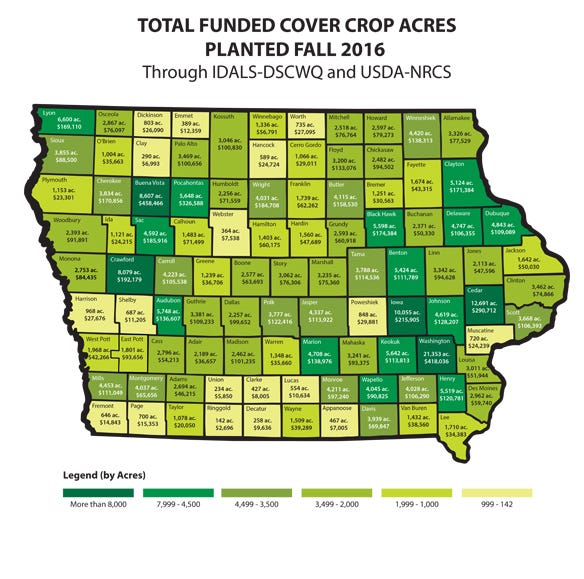June 8, 2017

Iowa farmers planted more than 353,000 acres of cover crops, with financial assistance from state and federal conservation programs in fall 2016 — nearly 18% more than the previous year.
Based on statewide surveys and aerial imagery completed by conservation groups this spring, Iowa agriculture officials estimate Iowa farmers planted a total of at least 600,000 cover crop acres last fall.
The new cover crop mark represents the second consecutive year with an increase of more than 60,000 acres. The total includes funding from the Iowa Department of Agriculture and Land Stewardship (IDALS) through the Iowa Water Quality Initiative, state cost-share, and local watershed projects. USDA’s Natural Resources Conservation Service provides farmers assistance for cover crops through the Environmental Quality Incentives Program (EQIP), Conservation Stewardship Program (CSP), and Regional Conservation Partnership Program (RCPP).
Washington County still leader
Cover crops such as cereal rye, winter wheat, oats, turnips and radishes are helping farmers provide timely ground cover and living roots in the soil before planting and after harvest. Cover crops increase organic matter in the soil, improve water infiltration, diversify biological activity in the soil, reduce soil erosion and weed competition, trap excess nutrients in the soil, and even provide livestock grazing.

Washington County, in southeast Iowa, planted the most cover crops using government planning and financial aid with 21,353 acres. Cedar and Iowa counties in eastern Iowa were next with 12,691 and 10,055 acres, respectively. Buena Vista County and Crawford County farmers in western Iowa planted 8,607 and 8,079 for the fourth and fifth most cover crop acres planted.
Washington County farmers led in cover crop acres for the second consecutive year. “This is a part of the state with a lot of early adopters and leaders in innovative soil and water conservation solutions,” says Iowa NRCS state agronomist Barb Stewart. “We often look to these farmers as spokespeople for promoting these practices to other farmers through field days, conferences and other sharing opportunities.”
Cover crop interest continues to grow
Iowa Agriculture Secretary Bill Northey says he is encouraged by the increase in cover crop acres throughout the state. “It’s obvious with the interest we’ve seen over the past few years that farmers are seeing the benefits that cover crops provide,” he says. “Cover crops are an important tool to help improve water quality and soil health in Iowa, and it is great to see an increasing number of farmers use this practice.”
Northey adds, “I encourage farmers to experiment and see how cover crops and other water quality improving practices can fit into their farming operations, so we can continue to make progress on this important issue.”
Over 600,000 acres of cover crops were planted last fall — not quite 3% of the state’s 23 million acres of corn and soybeans. That’s a small percentage compared to the 12.6 million acres of covers called for in the Iowa Nutrient Reduction Strategy, “but the trend shows more and more farmers are adopting this simple practice to protect clean water and control erosion,” notes Northey. “There is more work to be done; we’d like to see many more acres planted to cover crops.”
For more information about cover crops and other practices and conservation programs to help address natural resource concerns on your land, visit your local USDA Service Center for planning assistance.
Johnson is a public affairs specialist for NRCS based in Des Moines.
About the Author(s)
You May Also Like




